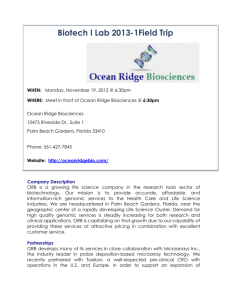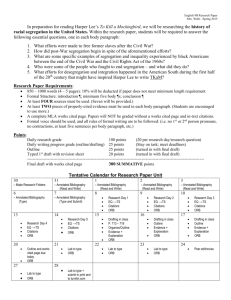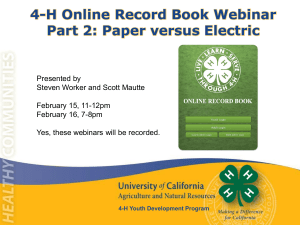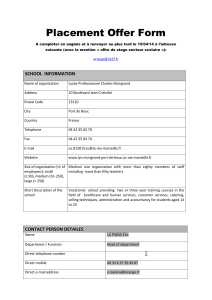PULLBACK AND FINITE COPRODUCT PRESERVING FUNCTORS BETWEEN CATEGORIES OF PERMUTATION
advertisement
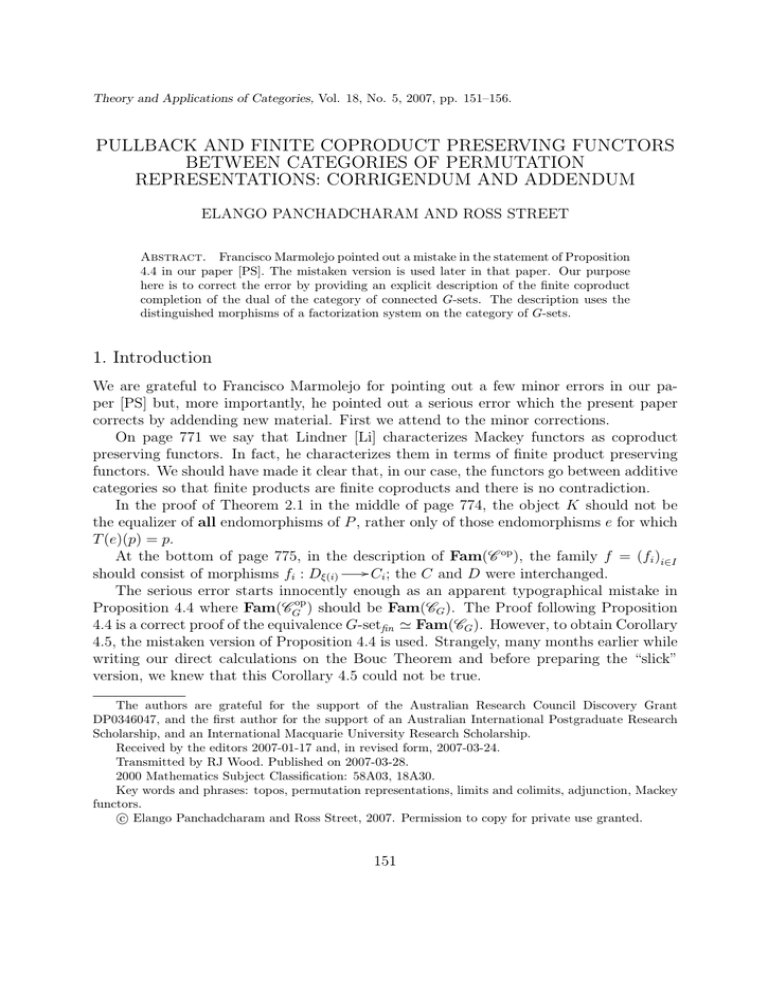
Theory and Applications of Categories, Vol. 18, No. 5, 2007, pp. 151–156.
PULLBACK AND FINITE COPRODUCT PRESERVING FUNCTORS
BETWEEN CATEGORIES OF PERMUTATION
REPRESENTATIONS: CORRIGENDUM AND ADDENDUM
ELANGO PANCHADCHARAM AND ROSS STREET
Abstract. Francisco Marmolejo pointed out a mistake in the statement of Proposition
4.4 in our paper [PS]. The mistaken version is used later in that paper. Our purpose
here is to correct the error by providing an explicit description of the finite coproduct
completion of the dual of the category of connected G-sets. The description uses the
distinguished morphisms of a factorization system on the category of G-sets.
1. Introduction
We are grateful to Francisco Marmolejo for pointing out a few minor errors in our paper [PS] but, more importantly, he pointed out a serious error which the present paper
corrects by addending new material. First we attend to the minor corrections.
On page 771 we say that Lindner [Li] characterizes Mackey functors as coproduct
preserving functors. In fact, he characterizes them in terms of finite product preserving
functors. We should have made it clear that, in our case, the functors go between additive
categories so that finite products are finite coproducts and there is no contradiction.
In the proof of Theorem 2.1 in the middle of page 774, the object K should not be
the equalizer of all endomorphisms of P , rather only of those endomorphisms e for which
T (e)(p) = p.
At the bottom of page 775, in the description of Fam(C op ), the family f = (fi )i∈I
/ Ci ; the C and D were interchanged.
should consist of morphisms fi : Dξ(i)
The serious error starts innocently enough as an apparent typographical mistake in
Proposition 4.4 where Fam(CGop ) should be Fam(CG ). The Proof following Proposition
4.4 is a correct proof of the equivalence G-setfin ' Fam(CG ). However, to obtain Corollary
4.5, the mistaken version of Proposition 4.4 is used. Strangely, many months earlier while
writing our direct calculations on the Bouc Theorem and before preparing the “slick”
version, we knew that this Corollary 4.5 could not be true.
The authors are grateful for the support of the Australian Research Council Discovery Grant
DP0346047, and the first author for the support of an Australian International Postgraduate Research
Scholarship, and an International Macquarie University Research Scholarship.
Received by the editors 2007-01-17 and, in revised form, 2007-03-24.
Transmitted by RJ Wood. Published on 2007-03-28.
2000 Mathematics Subject Classification: 58A03, 18A30.
Key words and phrases: topos, permutation representations, limits and colimits, adjunction, Mackey
functors.
c Elango Panchadcharam and Ross Street, 2007. Permission to copy for private use granted.
151
152
ELANGO PANCHADCHARAM AND ROSS STREET
To correct the error, we require a nice description of the finite coproduct completion
Fam(CGop ) of the dual of the category of connected G-sets. This nice category will replace
G-setfin in Corollary 4.5 and have repercussions for Corollary 4.7, Theorem 5.1 and Theorem 5.3. To describe the category, we will use the morphisms of a factorization system
on G-set. We are grateful to Alexei Davydov for valuable discussions on this material.
2. A factorization for G-morphisms
For any G-set X, we have the set X/G = {C ⊆ X : C is an orbit of X} of connected
/ X/G taking each element x ∈ X to
sub-G-sets of X. We have the function orb : X
/ Y induces a direct image
its orbit orb(x) = {gx : g ∈ G}. Each G-morphism f : X
/ Y /G defined by (f /G)(C) = f∗ (C).
function f /G : X/G
/ Y is said to be slash inverted when f /G : X/G
/ Y /G is
A G-morphism f : X
a bijection.
/ Y is slash inverted if and only if it is
2.1. Proposition. A G-morphism f : X
surjective and f (x1 ) = f (x2 ) implies orb(x1 ) = orb(x2 ).
Proof. Suppose f is slash inverted. For each y ∈ Y there exists x ∈ X with f∗ (orb(x)) =
orb(y). So f (x) = gy for some g ∈ G. It follows that y = f (g −1 x), so f is surjective.
If f (x1 ) = f (x2 ) then (f /G)(orb(x1 )) = (f /G)(orb(x2 )); so orb(x1 ) = orb(x2 ). For the
converse, take orb(y) ∈ Y /G. Then y = f (x) for some x ∈ X and so orb(f (x)) = orb(y).
Also, if orb(f (x1 ) = orb(f (x2 )), then f (x1 ) = gf (x2 ) = f (gx2 ) for some g ∈ G. So
orb(x1 ) = orb(gx2 ) = orb(x2 ).
/ Y is said to be orbit injective when orb(x1 ) = orb(x2 ) and
A G-morphism f : X
f (x1 ) = f (x2 ) imply x1 = x2 . Orbit injective morphisms were considered by Bouc [Bo].
2.2. Proposition. The slash inverted and orbit injective G-morphisms form a factorization system (in the sense of [FK]) on the category of G-sets.
P
/ Y , construct the G-set S =
f∗ (C) and
Proof. To factor a G-morphism f : X
C∈X/G
define G-morphisms u : X
/ S and v : S
/ Y by
u(x) = f (x) ∈ f∗ (orb(x)) and v(y ∈ f∗ (C)) = y.
Then f = v ◦ u while u is slash inverted and v is orbit injective.
The only other non-obvious thing remaining to prove is the diagonal fill-in property.
For this, suppose k ◦ u = v ◦ h where u is slash inverted and v is orbit injective.
If u(x1 ) = u(x2 ) then orb(x1 ) = orb(x2 ), so orb(h(x1 )) = orb(h(x2 )). Yet we also have
v(h(x1 )) = k(u(x1 )) = k(u(x2 )) = v(h(x2 )). Since v is orbit injective, we deduce that
h(x1 ) = h(x2 ).
Since u is surjective, for each s ∈ S there is an x ∈ X with u(x) = s. By the last
paragraph, the value h(x) is independent of the choice of x. So we obtain a function r by
defining r(s) = h(x). Clearly r is a G-morphism with r ◦ u = h and v ◦ r = k; and r is
unique since u is surjective.
PERMUTATION REPRESENTATIONS: CORRIGENDUM AND ADDENDUM
153
This factorization system has a special property.
2.3. Proposition. The pullback of a slash inverted G-morphism along an orbit injective
G-morphism is slash inverted.
/ S are slash inverted and
/ S and v : Y
Proof. Suppose the G-morphisms u : X
/X
orbit injective, respectively. Let P be the pullback of u and v with projections p : P
/ Y . We claim that q is slash inverted. It is clearly surjective so suppose that
and q : P
q(x1 , y1 ) = q(x2 , y2 ) where u(x1 ) = v(y1 ) and u(x2 ) = v(y2 ). So y1 = y2 and u(x1 ) = u(x2 ).
Since u is slash inverted, orb(x1 ) = orb(x2 ); so there exists g ∈ G with x2 = gx1 . Since
y1 and gy1 are in the same orbit, the calculation
v(gy1 ) = gv(y1 ) = gu(x1 ) = u(gx1 ) = u(x2 ) = v(y2 ) = v(y1 )
implies that gy1 = y1 = y2 . So g(x1 , y1 ) = (x2 , y2 ), which implies that (x1 , y1 ) and (x2 , y2 )
are in the same orbit.
3. A new category of G-sets
For a finite group G, we write G-setfin for the category of finite G-sets and G-morphisms.
We write CG for (a skeleton of) the category of connected finite G-sets and all Gmorphisms between them. There is also the category Spn(G-setfin ) whose objects are
finite G-sets and whose morphisms are isomorphism classes of spans between finite G-sets.
All these categories are important for the study of Mackey functors.
However, we now wish to introduce another category BG whose objects are all the
finite G-sets. In fact, BG is the subcategory of Spn(G-setfin ) whose morphisms are
/ X is slash
/ Y in which u : S
the isomorphism classes of those spans (u, S, v) : X
/ Y is orbit injective. It follows from Proposition 2.2 and Proposition
inverted and v : S
2.3 that these particular spans are closed under span composition.
3.1. Proposition. The subcategory BG of Spn(G-setfin ) is closed under finite coproducts.
Proof. The coproduct in Spn(G-setfin ) is that of G-setfin , namely, disjoint union. For
G-sets X and Y , the coprojections X + Y in Spn(G-setfin ) are the spans
(1X , X, copr1 ) : X
/ X + Y and (1Y , Y, copr ) : Y
2
/X + Y
/ Z and (h, T, k) :
which clearly yield morphisms in BG . Moreover, if (u, S, v) : X
/
Y
Z are spans with u and h slash inverted and with v and k orbit injective then
/ X + Y is slash inverted and [v, k] : S + T
/ Z orbit injective. So the
u+h:S+T
/
induced span (u + h, S + T, [v, k]) : X + Y
Z yields a morphism in BG .
154
ELANGO PANCHADCHARAM AND ROSS STREET
3.2. Remark. While the coproduct in Spn(G-setfin ) is also the product (since Spn(G-setfin )
is self dual), this is no longer true in BG .
/ BG taking each connected G-set to itself and each GThere is a functor CGop
/
morphism f : C
D between connected G-sets to the isomorphism class of the span
/
C; clearly f must be slash inverted since C and D each have one
(f, C, 1C ) : D
orbit. Using the universal property of Fam(CGop ) and Proposition 3.1, we obtain a finite
/ BG extending C op
/ BG .
coproduct preserving functor Σ : Fam(CGop )
G
3.3. Theorem. The functor Σ : Fam(CGop )
/ BG is an equivalence of categories.
Proof. Each object of BG is a coproduct of connected G-sets so Σ is certainly essentially
surjective on objects. To prove Σ fully faithful we need to use the description of Fam(CGop )
from the bottom of page 775 of [PS] as corrected above. The objects are finite families
/ (Dj )
(Ci )i∈I of connected G-sets and a morphism (ξ, f ) : (Ci )i∈I
j∈J consists of a
/ Ci . The functor
/
J and a family f = (fi )i∈I of morphisms fi : Dξ(i)
function ξ : I
/ (Dj )
Σ takes the morphism (ξ, f ) : (Ci )i∈I
to the isomorphism class of the span
P
Pj∈J
P
/
(u, S, v) : X
Y where X = i∈I Ci , Y = j∈J Dj , S = i∈I Dξ(i) ,
u ◦ copri = copri ◦ fi and v ◦ copri = coprξ(i) .
/ X/G and that both of these sets are isomorphic
Notice that u induces a bijection S/G
to I. It is then clear that u is slash inverted and v is orbit injective. Yet this process can
/ Y for the same X and Y , with u
be inverted as follows. Given any span (u, S, v) : X
slash inverted and v orbit injective, the direct image v∗ u∗ (Ci ) of the inverse image u∗ (Ci )
of Ci must be an orbit Dξ(i) of Y . This defines a function ξ while fi is the composite
of the restriction of u to u∗ (Ci ) with the inverse of the isomorphism u∗ (Ci ) ∼
= v∗ u∗ (Ci )
induced by v.
The correct version of Corollary 4.5 of [PS] is
3.4. Corollary. There is an equivalence
BG ' CopPb(G-setfin , setfin )
taking the left G-set C to the functor
X
G-setfin (Cw , −)
w∈C/G
where Cw is the orbit w as a sub-G-set of C.
The correct version of Corollary 4.7 is
3.5. Corollary. There is an equivalence
BGop ' CopPb(G-setfin , setfin ),
A
/ A ◦G −,
which on morphisms, takes a span (u, S, v) from A to B with u slash inverting and v
orbit injective, to the natural transformation whose component at X is the function A ◦G
/ B ◦G X taking [a, x] to [v(s), x] where u(s) = a.
X
PERMUTATION REPRESENTATIONS: CORRIGENDUM AND ADDENDUM
155
4. The bicategory of finite groups
The definition of the bicategory Bouc in Section 5 of [PS] must be modified in the light
of the above corrections to Corollaries 4.5 and 4.7.
For any finite monoid H and any category X with finite coproducts,
there is a monad
P
H· on X whose underlying endofunctor is defined by H · X = H X (the coproduct of
H copies of X); the unit and multiplication are induced in the obvious way by the unit
and multiplication of H. The category X H· of Eilenberg-Moore algebras for the monad
is none other than the functor category [H, X ] where H is regarded as a category with
one object and with morphisms the elements of H. We are interested in the particular
case where H is a finite group and X = BGop .
Define Bouc(G, H) to be the category obtained as the pullback of the inclusion of BGop
/ Spn(Gop -setfin ).
in Spn(Gop -setfin ) along the forgetful functor Spn(Gop × H-setfin )
That is, Bouc(G, H) is the subcategory of Spn(Gop ×H-setfin ) consisting of all the objects
yet, as morphisms, only the isomorphism classes of spans (u, S, v) in Gop × H-setfin for
which u is slash inverted and v is orbit injective as G-morphisms.
/ [H, BGop ] defined as follows.
There is an isomorphism of categories Γ : Bouc(G, H)
op
For each G × H-set A, the left action by H provides injective right G-morphisms h :
/ A for all h ∈ H; so the isomorphism class of the span (1A , A, h) : A
/ A is a
A
morphism in BGop . So the right G-set underlying A becomes a left H-object ΓA in BGop .
Conversely, each left H-object X in BGop has, for each h ∈ H, an invertible morphism
/ X in BGop ; it follows that uh and vh are invertible and so [uh , Mh , vh ]=
[uh , Mh , vh ] : X
/ X define a left H-action on X making it a Gop × H-set
[1X , X, wh ] where the wh : X
A with ΓA = X. That Γ is fully faithful should now be obvious.
The correct form of Theorem 5.1 of [PS] is:
4.1. Theorem. There is an equivalence of categories
Bouc(G, H) ' CopPb(G-setfin , H-setfin ),
A
/ A ◦G −.
The correct form of the first sentence of Theorem 5.3 of [PS] is:
4.2. Theorem. There is a bicategory Bouc whose objects are finite groups, whose homcategories are the categories
Bouc(G, H)
and whose composition functors are
Bouc(G, H) × Bouc(K, G)
/ Bouc(K, H),
(A, B) / A ◦G B.
References
[Bo] S. Bouc, Construction de foncteurs entre catégories de G-ensembles, Journal of
Algebra 183 (1996), 737–825.
156
ELANGO PANCHADCHARAM AND ROSS STREET
[FK] P. Freyd and G. M. Kelly, Categories of continuous functors I, Journal of Pure and
Applied Algebra 2 (1972), 169–191.
[Li]
H. Lindner, A remark on Mackey functors, Manuscripta Mathematica 18 (1976),
273–278.
[PS] E. Panchadcharam and R. Street, Pullback and finite coproduct preserving functors between categories of permutation representations, Theory and Applications of
Categories 16 (2006), 771–784.
Centre of Australian Category Theory, Macquarie University,
New South Wales, 2109, Australia
Email: {elango,street@maths.mq.edu.au
This article may be accessed at http://www.tac.mta.ca/tac/ or by anonymous ftp at
ftp://ftp.tac.mta.ca/pub/tac/html/volumes/18/5/18-05.{dvi,ps,pdf}
THEORY AND APPLICATIONS OF CATEGORIES (ISSN 1201-561X) will disseminate articles that
significantly advance the study of categorical algebra or methods, or that make significant new contributions to mathematical science using categorical methods. The scope of the journal includes: all areas of
pure category theory, including higher dimensional categories; applications of category theory to algebra,
geometry and topology and other areas of mathematics; applications of category theory to computer
science, physics and other mathematical sciences; contributions to scientific knowledge that make use of
categorical methods.
Articles appearing in the journal have been carefully and critically refereed under the responsibility of
members of the Editorial Board. Only papers judged to be both significant and excellent are accepted
for publication.
Full text of the journal is freely available in .dvi, Postscript and PDF from the journal’s server at
http://www.tac.mta.ca/tac/ and by ftp. It is archived electronically and in printed paper format.
Subscription information. Individual subscribers receive abstracts of articles by e-mail as they
are published. To subscribe, send e-mail to tac@mta.ca including a full name and postal address. For institutional subscription, send enquiries to the Managing Editor, Robert Rosebrugh, rrosebrugh@mta.ca.
The typesetting language of the journal is TEX, and LATEX2e
strongly encouraged. Articles should be submitted by e-mail directly to a Transmitting Editor. Please
obtain detailed information on submission format and style files at http://www.tac.mta.ca/tac/.
Information for authors.
Managing editor. Robert Rosebrugh, Mount Allison University: rrosebrugh@mta.ca
TEXnical editor. Michael Barr, McGill University: mbarr@barrs.org
Transmitting editors.
Richard Blute, Université d’ Ottawa: rblute@uottawa.ca
Lawrence Breen, Université de Paris 13: breen@math.univ-paris13.fr
Ronald Brown, University of North Wales: r.brown@bangor.ac.uk
Aurelio Carboni, Università dell Insubria: aurelio.carboni@uninsubria.it
Valeria de Paiva, Xerox Palo Alto Research Center: paiva@parc.xerox.com
Ezra Getzler, Northwestern University: getzler(at)math(dot)northwestern(dot)edu
Martin Hyland, University of Cambridge: M.Hyland@dpmms.cam.ac.uk
P. T. Johnstone, University of Cambridge: ptj@dpmms.cam.ac.uk
G. Max Kelly, University of Sydney: maxk@maths.usyd.edu.au
Anders Kock, University of Aarhus: kock@imf.au.dk
Stephen Lack, University of Western Sydney: s.lack@uws.edu.au
F. William Lawvere, State University of New York at Buffalo: wlawvere@acsu.buffalo.edu
Jean-Louis Loday, Université de Strasbourg: loday@math.u-strasbg.fr
Ieke Moerdijk, University of Utrecht: moerdijk@math.uu.nl
Susan Niefield, Union College: niefiels@union.edu
Robert Paré, Dalhousie University: pare@mathstat.dal.ca
Jiri Rosicky, Masaryk University: rosicky@math.muni.cz
Brooke Shipley, University of Illinois at Chicago: bshipley@math.uic.edu
James Stasheff, University of North Carolina: jds@math.unc.edu
Ross Street, Macquarie University: street@math.mq.edu.au
Walter Tholen, York University: tholen@mathstat.yorku.ca
Myles Tierney, Rutgers University: tierney@math.rutgers.edu
Robert F. C. Walters, University of Insubria: robert.walters@uninsubria.it
R. J. Wood, Dalhousie University: rjwood@mathstat.dal.ca

